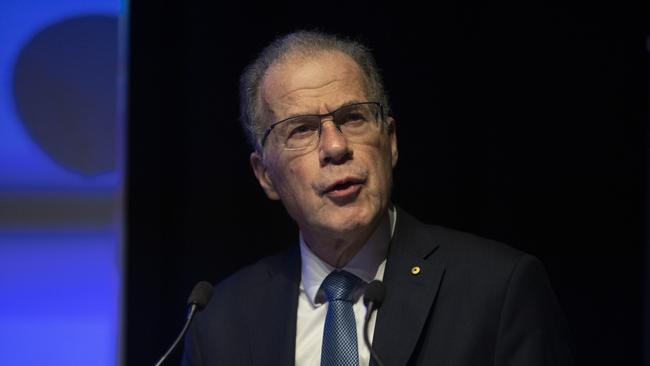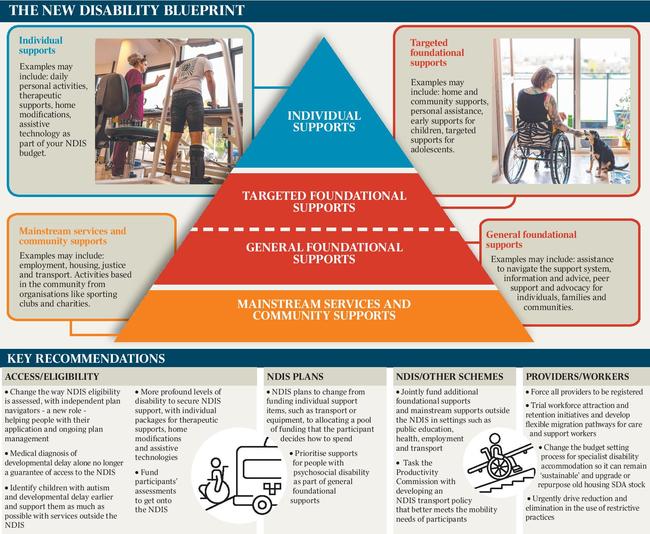Dozens of major reforms recommended by NDIS Review
NDIS eligibility should be determined by how a person’s disability affects their everyday life a review of the $42bn scheme says.

NDIS access based on a medical diagnosis should end and eligibility determined instead by how a person’s disability affects their everyday life, a landmark review says, as it looks to secure the $42bn scheme’s long-term future.
The NDIS review also demands states and territories step up and do more for people with less profound disabilities by spending billions of dollars more to provide mainstream services in areas such as public education, health and transport.
And it proposes governments provide “foundational supports” to those who fall short of requiring individual NDIS packages, with funding for support around the home, personal assistance and early interventions for children.
Ten years after the launch of the National Disability Insurance Scheme, a decade marked by rising costs, higher than expected participant numbers and an abandonment of support provided outside the scheme, Bill Shorten said it was time for NDIS Mark II.
“Mark I of the NDIS, launched in 2013, has delivered a lot for Australians with disability,” Mr Shorten said in launching the review.
“(But) it’s veered off track. Now we need to finish the job and reboot the DNIS to deliver Mark II of the scheme.”
The review’s 329-page final report – which draws from the nearly 4000 submissions received over the last 12 months – offers 26 recommendations and 139 actions it proposes be rolled out over the next five years.
It calls for NDIS eligibility to shift away from being based on a medical diagnosis to someone’s “functional impairment”, meaning a diagnosis of a condition such as autism would not guarantee access to the scheme.

“Access should be based on the impact your disability or disabilities have on your day-to-day life,” it says. “It should not be based on a medical diagnosis alone or just your primary diagnosis.”
More than 270,000 of the 630,000 current NDIS participants are children, the majority with a primary diagnosis of autism.
The recent influx of children on to the scheme is one of the reasons costs have soared by 14 per cent annually in recent years, heading to $100bn by 2032. The cost trajectory prompted national cabinet in April to impose an 8 per cent cost annual growth target by 2026.
On Wednesday, in recognition of the review’s recommendations, national cabinet agreed to spend more money on disability support outside the scheme, sharing the costs 50-50. The announcement was part of a broader deal involving changes to GST arrangement and health funding.
Mr Shorten said the government would work through the review’s recommendations and report in the first half of next year.
“It is important that Australians understand changes are not going to happen overnight and any reforms adopted by the Albanese government will be developed with the disability community to ensure a better NDIS.”
The review, headed by disability advocate Bruce Bonyhady and former senior public servant Lisa Paul, was initiated to examine how to make the NDIS sustainable and improve the experience for participants. “We understand that amongst the disability community, the term sustainability has become synonymous with cuts,” the review said. “We want to be clear that we have not designed these reforms to fit targets agreed by government.”

Among the recommendations under review is the mandatory registration of disability service providers to ensure better oversight and stop rorting.
“Providers can’t continue to fly under the radar,” the review said.
Another major change would be to the way NDIS eligibility is assessed, with the review recommending independent “plan navigators” help people with their application and ongoing plan management. Many of these navigators would be existing support co-ordinators transitioned into the new role, and would help people both on and off the NDIS find the services they needed.
NDIS plans should also change from funding “individual support items”, such as transport or equipment, to allocating a pool that the participant decides how to spend.
“The National Disability Insurance Agency should allow greater flexibility in how participants can spend their budget,” the report stated.
The review noted its reforms would only be achieved by strengthening the workforce, following warnings from unions over massive shortfalls in the sector.
“The Australian government should design and trial workforce attraction and retention initiatives … (and) develop targeted and flexible migration pathways for care and support workers,” it stated.
Other recommendations went to repurposing ageing specialist disability accommodation stock, moving to full electronic payments, developing a national transport policy for disabled Australians and implementing a new stream for people to access the NDIS who have been in accidents.







To join the conversation, please log in. Don't have an account? Register
Join the conversation, you are commenting as Logout